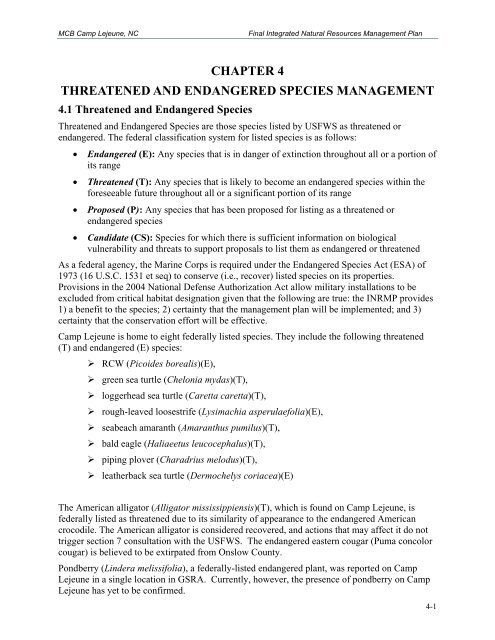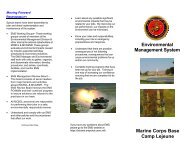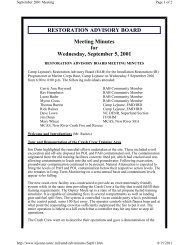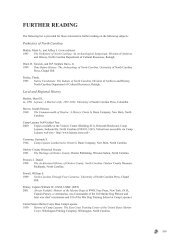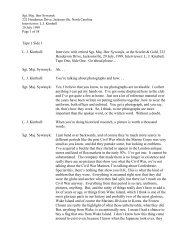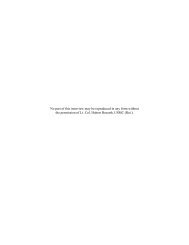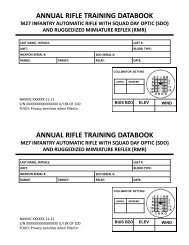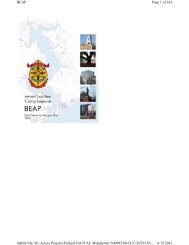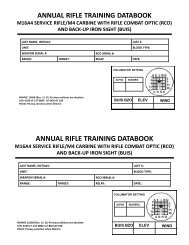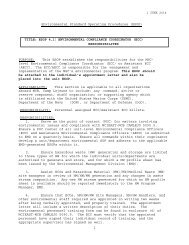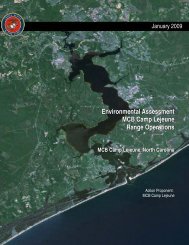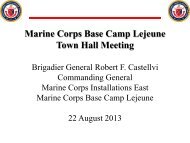CHAPTER 4 - Marine Corps Base Camp Lejeune
CHAPTER 4 - Marine Corps Base Camp Lejeune
CHAPTER 4 - Marine Corps Base Camp Lejeune
- No tags were found...
You also want an ePaper? Increase the reach of your titles
YUMPU automatically turns print PDFs into web optimized ePapers that Google loves.
MCB <strong>Camp</strong> <strong>Lejeune</strong>, NCFinal Integrated Natural Resources Management Plan<strong>CHAPTER</strong> 4THREATENED AND ENDANGERED SPECIES MANAGEMENT4.1 Threatened and Endangered SpeciesThreatened and Endangered Species are those species listed by USFWS as threatened orendangered. The federal classification system for listed species is as follows:• Endangered (E): Any species that is in danger of extinction throughout all or a portion ofits range• Threatened (T): Any species that is likely to become an endangered species within theforeseeable future throughout all or a significant portion of its range• Proposed (P): Any species that has been proposed for listing as a threatened orendangered species• Candidate (CS): Species for which there is sufficient information on biologicalvulnerability and threats to support proposals to list them as endangered or threatenedAs a federal agency, the <strong>Marine</strong> <strong>Corps</strong> is required under the Endangered Species Act (ESA) of1973 (16 U.S.C. 1531 et seq) to conserve (i.e., recover) listed species on its properties.Provisions in the 2004 National Defense Authorization Act allow military installations to beexcluded from critical habitat designation given that the following are true: the INRMP provides1) a benefit to the species; 2) certainty that the management plan will be implemented; and 3)certainty that the conservation effort will be effective.<strong>Camp</strong> <strong>Lejeune</strong> is home to eight federally listed species. They include the following threatened(T) and endangered (E) species:‣ RCW (Picoides borealis)(E),‣ green sea turtle (Chelonia mydas)(T),‣ loggerhead sea turtle (Caretta caretta)(T),‣ rough-leaved loosestrife (Lysimachia asperulaefolia)(E),‣ seabeach amaranth (Amaranthus pumilus)(T),‣ bald eagle (Haliaeetus leucocephalus)(T),‣ piping plover (Charadrius melodus)(T),‣ leatherback sea turtle (Dermochelys coriacea)(E)The American alligator (Alligator mississippiensis)(T), which is found on <strong>Camp</strong> <strong>Lejeune</strong>, isfederally listed as threatened due to its similarity of appearance to the endangered Americancrocodile. The American alligator is considered recovered, and actions that may affect it do nottrigger section 7 consultation with the USFWS. The endangered eastern cougar (Puma concolorcougar) is believed to be extirpated from Onslow County.Pondberry (Lindera melissifolia), a federally-listed endangered plant, was reported on <strong>Camp</strong><strong>Lejeune</strong> in a single location in GSRA. Currently, however, the presence of pondberry on <strong>Camp</strong><strong>Lejeune</strong> has yet to be confirmed.4-1
MCB <strong>Camp</strong> <strong>Lejeune</strong>, NCFinal Integrated Natural Resources Management PlanThe waters off of <strong>Camp</strong> <strong>Lejeune</strong> provide seasonal habitat for seven additional endangeredspecies of marine mammals: fin whale (Balaenoptera physalus), humpback whale (Megapteranovaeangliae), northern right whale (Balaena glacialis), sei whale (Balaenoptera borealis),sperm whale (Physeter catodon), and West Indian manatee (Trichechus manatus), and threeadditional endangered sea turtle species: leatherback sea turtle (Dermochelys coriacea), Kemp’sridley sea turtle (Lepidochelys kempii), and hawksbill sea turtle (Eretmochelys imbricata).Additionally the shortnose sturgeon (Acipenser brevirostrum), an endangered fish, may inhabitwaters off of <strong>Camp</strong> <strong>Lejeune</strong>. There are measures in place to protect marine species from trainingimpacts; <strong>Camp</strong> <strong>Lejeune</strong>’s Range Control SOP (BO 3570.1A) provides guidance to water-borneoperations to avoid impacts to manatees and other protected species. Management of the oceanwaters falls under the authority of the National Oceanographic and Atmospheric Administration(NOAA) – Fisheries. <strong>Camp</strong> <strong>Lejeune</strong> will consult with NOAA Fisheries on any <strong>Camp</strong> <strong>Lejeune</strong>sponsoredactivities that may affect marine species under NOAA jurisdiction.<strong>Camp</strong> <strong>Lejeune</strong> intends to utilize an ecosystem-based approach with respect to natural resourcemanagement. However, special attention is given to threatened and endangered species and theirhabitats to prevent “jeopardy,” and to manage for conservation and recovery of those species.Consequently, <strong>Camp</strong> <strong>Lejeune</strong> has implemented programs to manage listed species and theirhabitats in order to sustain and recover endangered species populations.<strong>Camp</strong> <strong>Lejeune</strong> regularly consults with the USFWS to ensure that <strong>Marine</strong> <strong>Corps</strong> actions are notlikely to jeopardize the continued existence of any endangered or threatened species and are incompliance with the ESA. Pursuant to Section 7 of the ESA, Federal agencies such as the <strong>Marine</strong><strong>Corps</strong> must consult with USFWS if their action "may affect" a federally listed endangered orthreatened species (50 CFR 402). Such consultations may be formal or informal. Whennecessary, <strong>Camp</strong> <strong>Lejeune</strong> prepares a biological assessment of the effects of a proposed action onlisted species. Section 9 of the ESA prohibits the “take” of a threatened or endangered species. A“take” includes the direct killing, harming, or harassing of a species, or destruction of habitat thatmay be important for the species' survival or recovery.The endangered species program can be categorized into three functional areas: protection,management and monitoring. The first line of defense for endangered species, and the mostimportant tool to avoid “take,” is protection of threatened and endangered species (individualsand populations) and their habitats from impacts due to training development or other actionsthat may affect the species. For most threatened and endangered species on base, this protectioncomes in the form of restricted access to a particular area, or restrictions on the type of activitiesthat may occur within a given area. Areas where activity is restricted due to the presence ofthreatened or endangered species will be clearly delineated with signs, paint, or other obviousmarkings. Protective measures for each species are specified in their respective sections below.In most cases ecosystem management activities, such as the use of prescribed fire, will benefitlisted species. However, in order to most effectively promote survival and recovery, <strong>Camp</strong><strong>Lejeune</strong> has identified specific management needs for each federally-listed species. Intensity ofmanagement for each species will vary depending on available scientific knowledge, and theability of <strong>Camp</strong> <strong>Lejeune</strong> to take actions that will effectively promote recovery of a given species.For example, in the case the RCW, there is ample scientific literature and anecdotal evidencesupporting the effectiveness of habitat alteration and creation of artificial cavities as a way topromote population growth.4-2
MCB <strong>Camp</strong> <strong>Lejeune</strong>, NCFinal Integrated Natural Resources Management PlanAlternatively, there is comparatively little that can be done to manage for seabeach amaranth, anunpredictable annual plant that tends to grow in areas that have been washed over by tidal action.In the case of the seabeach amaranth, protection, rather than management, is the most effectivetool to promote the continued existence of the species. For RCWs, protection of clusters is alsoimportant, but these sites would soon be abandoned without proper management. For threatenedor endangered species, <strong>Camp</strong> <strong>Lejeune</strong> has relied on available scientific literature, expert advice,and local experience to devise plans and protocols that promote the survival and recovery of eachspecies.In order to gauge the effectiveness of management activities and to assess any population trends,an effective monitoring program must be implemented for each species. Also, monitoring is anessential aspect of any adaptive management program. <strong>Camp</strong> <strong>Lejeune</strong> has implementedmonitoring protocols for each threatened or endangered species. As with management activitiesdiscussed above, the intensity of the monitoring will depend on the type and amount ofinformation needed to carry out an effective program.<strong>Camp</strong> <strong>Lejeune</strong>’s Threatened and Endangered Species Program has several overarchingrequirements that direct conservation management and more specific goals for each threatenedand endangered species. First, <strong>Camp</strong> <strong>Lejeune</strong> will conserve and manage threatened andendangered species in accordance with all environmental laws and their implementingregulations, as well as terms and conditions outlined in applicable USFWS biological opinions.Compliance with the ESA is an important part of protecting <strong>Camp</strong> <strong>Lejeune</strong>’s primary mission oftraining and maintaining combat ready troops. In order to do this, <strong>Camp</strong> <strong>Lejeune</strong> can implementrecovery plan guidelines, as well as any terms and conditions of past and future biologicalopinions. <strong>Camp</strong> <strong>Lejeune</strong> will actively manage for recovery of known populations of threatenedand endangered species and will periodically and systematically survey for new populations.Second, <strong>Camp</strong> <strong>Lejeune</strong> will incorporate principles of ecosystem management into threatened andendangered species management. Although the threatened and endangered species program mustensure that each species receives appropriate management attention, much of the managementthat benefits each species can also benefit other species and the ecosystem as a whole. A goodexample of this is habitat management for RCW. By managing for RCW, <strong>Camp</strong> <strong>Lejeune</strong> isrestoring and improving the longleaf pine wiregrass ecosystem that many other species, such asBachman’s sparrow, brown-headed nuthatch and many rare plants depend on.Finally, <strong>Camp</strong> <strong>Lejeune</strong> will support research on the population dynamics of threatened andendangered species in order to make recommendations that assist in their survival and recovery.The <strong>Base</strong> has been recognized nationally for its conservation efforts in this regard.4.2 Critical HabitatWith the passing of the National Defense Authorization Act of 2004, military lands were grantedan exemption from the designation of critical habitat for endangered species, provided that anINRMP provides a benefit to threatened and endangered species. In order to meet the standardfor exemption, an INRMP must meet the criteria discussed earlier in Chapter 1, Section 1.2.10;that is:• Provide a benefit to threatened and endangered species;• The installation must provide certainty that it will be implemented; and• The plan must be effective, and should be developed with cooperating agencies thatinclude USFWS and state fish and wildlife agencies.4-3
MCB <strong>Camp</strong> <strong>Lejeune</strong>, NCFinal Integrated Natural Resources Management PlanOf the threatened and endangered species listed above, only the piping plover and green seaturtle have had critical habitat designated by USFWS. Of these two, only the piping plover hashad critical habitat designated in the continental United States. In 2001, the Fish and WildlifeService designated several areas along the North Carolina Coast as critical wintering habitat forthe piping plover, with the closest habitat occurring at New Topsail Inlet just south of the <strong>Base</strong>on the Atlantic Coast. There is no designated critical habitat on <strong>Marine</strong> <strong>Corps</strong> <strong>Base</strong> <strong>Camp</strong><strong>Lejeune</strong>.Outlined below are programs that address protection, management and monitoring for allthreatened and endangered species that regularly occur on <strong>Camp</strong> <strong>Lejeune</strong>. It is <strong>Camp</strong> <strong>Lejeune</strong>’sbelief that this INRMP provides a conservation benefit to each of these species, and that the listof actions given in the Course of Action and Monitoring table (Appendix C), and the Benefits toSpecies Table (Appendix D) outline a clear, measurable path to implementation. Further, <strong>Camp</strong><strong>Lejeune</strong> believes that the Threatened and Endangered species programs described in this chaptermeet the necessary requirements to obviate the need to designate critical habitat on <strong>Camp</strong><strong>Lejeune</strong> for any of the threatened and endangered species on base. The US Fish & WildlifeService has been regularly consulted with regard to the synthesis of these programs. For moreinformation on this subject see Chapter 15.4.3 Threatened and Endangered Species Management4.3.1 Red–cockaded Woodpecker<strong>Camp</strong> <strong>Lejeune</strong> currently supports 81 active RCW clusters. Since 1986, when intensivepopulation monitoring began, <strong>Camp</strong> <strong>Lejeune</strong>’s RCW population has increased 161%, from 31clusters in 1986 to 81 active clusters in 2005 (Figure 4-1). Since 1990, <strong>Camp</strong> <strong>Lejeune</strong>’s RCWpopulation has averaged more than 9% growth per year. This significant growth is attributed tomany factors, including the success of artificial cavity provisioning, increased growing seasonburns and an aging forest with a surplus of non-breeding individuals in the population (JeffWalters, 2001 <strong>Camp</strong> <strong>Lejeune</strong> RCW Report). Locations of active and inactive clusters are shownin Figure 4-2.Figure 4-1. Number of active RCW clusters on <strong>Marine</strong> <strong>Corps</strong> <strong>Base</strong> <strong>Camp</strong> <strong>Lejeune</strong> from 1986 to 20059080706050403020100Active Clusters200520042003200220012000199919981997199619951994199319921991199019891988198719864-4
MCB <strong>Camp</strong> <strong>Lejeune</strong>, NCFinal Integrated Natural Resources Management PlanFigure 4-2. Active and inactive RCW clusters on <strong>Marine</strong> <strong>Corps</strong> <strong>Base</strong> <strong>Camp</strong> <strong>Lejeune</strong> as of April, 2006.4.3.1.1 Previous Consultation (1999 RCW Plan)In 1999, <strong>Camp</strong> <strong>Lejeune</strong> coordinated with the USFWS to develop the Mission-Compatible, Long-Range RCW Management Plan (1999 RCW Plan). The plan was endorsed in December 1999with implementation initiated in 2000. The Biological Opinion supporting plan implementationwas signed November 30, 1999. The 1999 RCW plan established a mission compatible RCWgoal of 173 active clusters, outlined management strategies and accounted for incidental take.According to the 1999 plan, all restrictions on the military mission will be removed once themission compatible goal of 173 clusters is met and maintained. Since the 1999 plan was written,several factors have prompted the need for a revision of <strong>Camp</strong> <strong>Lejeune</strong>’s RCW managementprogram: the most recent 2003 RCW Recovery Plan, the completed <strong>Camp</strong> <strong>Lejeune</strong> RCWMilitary Impacts Study (Appendix G), and the Endangered Species Act amendments containedin the 2004 National Defense Authorization Act regarding critical habitat on military lands.However, several key sections of the 1999 RCW Plan and subsequent USFWS BiologicalOpinion remain unchanged and valid for this plan. Below are aspects of the 1999 RCW Plan thatwill carry over to the current plan:Mission Compatible Recovery Goal: The 1999 RCW Management Plan set a local recoverygoal of 173 active clusters within seven management areas on Mainside <strong>Camp</strong> <strong>Lejeune</strong>.Mainside is comprised of all base management areas except Greater Sandy Run Area (GSRA)(Figure 4-3). This goal was based on available acreage and accounted for incidental take in4-5
MCB <strong>Camp</strong> <strong>Lejeune</strong>, NCFinal Integrated Natural Resources Management Plansupport of mission essential construction and range development in the GSRA, MechanizedAssault Course, and the Cantonment-Housing Area.Figure 4-3. RCW management areas on <strong>Marine</strong> <strong>Corps</strong> <strong>Base</strong> <strong>Camp</strong> <strong>Lejeune</strong>Management Practices: Several practices remain essentially unchanged under the current plan.They include guidelines relating to recruitment stands, artificial cavities, cavity restrictors,translocation/augmentation, cluster reconfiguration, vegetation management treatments,prescribed burning use and southern pine beetle suppression.To achieve the RCW goal, the 1999 plan established a method of recruitment site identification,partitioning, provisioning (establishing new clusters), and habitat management. Recruitment siteswere identified and assigned a projected provisioning time period based on stand age andproximity to existing clusters. Beneficial silvicultural techniques and prescribed fire werehighlighted in the plan, as the need to improve habitat while retaining older, more mature treeswas recognized. Partitions, averaging 200 acres, were assigned to each recruitment site thatpossessed continuous current or potential foraging habitat. Although the partition layer has beena valuable management tool, the vision of treating RCW partitions as management units was notfully realized under the previous plan.Monitoring and evaluation: The <strong>Base</strong> will continue to conduct on-going monitoring andevaluation as required by the 1999 BO.Periodic Plan evaluation: The INRMP is reviewed annually in cooperation with the USFWSthe North Carolina Wildlife Resources Commission, and the North Carolina Division of <strong>Marine</strong>Fisheries.4-6
MCB <strong>Camp</strong> <strong>Lejeune</strong>, NCFinal Integrated Natural Resources Management PlanIncidental Take: Due to the relatively young nature of the forest in the GSRA, and the need todevelop additional ranges, GSRA does not contribute to <strong>Camp</strong> <strong>Lejeune</strong>’s RCW goal. <strong>Base</strong>d onavailable habitat in GSRA, the 1999 plan identified up to 50 potential RCW clusters in GSRAsubject to incidental take. The amount of potential RCW habitat in GSRA is currently being reevaluated,but all RCWs in GSRA will still be subject to an incidental take statement.Likewise, in support of future facility development, up to 6 RCW clusters in the Cantonment-Housing Area on Mainside <strong>Camp</strong> <strong>Lejeune</strong> are subject to incidental take.The 1999 plan identified 5 potential RCW clusters subject to incidental take for the MechanizedAssault Course (MAC). Due to changes in range development requirements, the MAC has beenresited to the GSRA which does not impact RCW recovery goals. However, up to 7 existingclusters will be subject to incidental take in a forthcoming consultation in support of future rangemodernization in and around the G10 impact area. Although this represents an increase of twoclusters when compared to the incidental take for the MAC in the 1999 RCW Plan, <strong>Camp</strong><strong>Lejeune</strong> does not intend to lower its recovery goal of 173 active clusters.4.3.1.2 RCW Management – 2006 PlanIn the current plan, RCW management on <strong>Camp</strong> <strong>Lejeune</strong> falls into three general categories:partition management, cluster management and protection, and population monitoring andmanagement. Separately, each is crucial to a successful RCW management program.Partition-Level Management: With the current plan, <strong>Camp</strong> <strong>Lejeune</strong> will begin treating RCWpartitions as management units for silvicultural activities. <strong>Camp</strong> <strong>Lejeune</strong> recently finisheddelineating 198 existing and future RCW partitions for the main side of base (Figure 4-4). Theobjective of partition-level management is to provide suitable habitat in each partition, and toFigure 4-4. RCW management partitions color coded to their management area.4-7
MCB <strong>Camp</strong> <strong>Lejeune</strong>, NCFinal Integrated Natural Resources Management Planimprove habitat with each subsequent management action. Conversion of off-site pine tolongleaf may create near and midterm exceptions to the continual improvement guidelines, butwill improve RCW habitat in the long term. A detailed explanation of Partition LevelManagement is provided in the 2006 <strong>Camp</strong> <strong>Lejeune</strong> RCW Recovery Plan (Appendix H), whichis a revision of the 1999 <strong>Base</strong> RCW Recovery Plan.Forest management will continue to operate at the compartment level (See Chapter 7 ForestManagement), treating each compartment on a 10-year cycle. However, compartments also willbe evaluated at the partition level to ensure that habitat being created provides benefits to RCW.Partitions will be assessed on the 10-year compartment schedule, with some exceptions.Partitions in urgent need of management, such as those expected to be occupied by RCWs in theshort term, will be addressed outside of the 10-year prescription cycle. Although partitions mayoverlap stand and compartment boundaries, most forest management will be prescribed at thestand level. Forest management will be consistent with all recommendations in the 2003 RCWRecovery Plan with respect to size of clearcuts and acceptable silvicultural techniques.<strong>Camp</strong> <strong>Lejeune</strong>’s forest management will emphasize increasing the amount of good qualityforaging habitat as described in the 2003 Recovery Plan, while also converting from offsitespecies to longleaf pine. RCW foraging habitat previously has been described by pine stockinglevels and the quantity of stems greater than 10” diameter–at-breast-height (DBH). Revisedforaging habitat guidelines from the 2003 RCW Recovery Plan 2 nd Revision (USFWS) arereproduced in Appendix H. Consistent with the new guidelines, <strong>Camp</strong> <strong>Lejeune</strong> will managetowards 120 acres of “good quality” habitat and will increase the acreage of habitat meetingsome or all of the characteristics of good quality habitat through the application of prescribedfire, silvicultural treatments (including pine thinning and canopy hardwood removal), andhardwood/midstory management. These new requirements also created a need to modify <strong>Base</strong>forest data collection to better quantify the variables contributing to good quality RCW foraginghabitat.Silvicultural practices (timber harvest treatments) are a main component of managing habitat forRCW. The Forestry section is responsible for prescribing silvicultural treatments to the <strong>Camp</strong><strong>Lejeune</strong> forest landscape, including all RCW partitions. The Threatened and Endangered Speciessection at <strong>Camp</strong> <strong>Lejeune</strong> works closely with the <strong>Camp</strong> <strong>Lejeune</strong> Forestry section to insure that allproposed silvicultural prescriptions will benefit RCW where appropriate, and that thoseprescriptions follow the guidelines of the 2003 Recovery Plan. Silvicultural activities to benefitRCW may include thinning of mature pine timber to 60 ft 2 of basal area, removal of maturecanopy hardwoods (canopy hardwoods are not to exceed 10% in good quality RCW habitat),retention of potential cavity trees, and two-aged and uneven-aged management for pine. Moredetails of the silvicultural silvicultural techniques can be found in Appendix I, SilviculturalSystems Utilized on <strong>Camp</strong> <strong>Lejeune</strong>.The role of fire in the longleaf pine/wiregrass ecosystem is varied and includes suppression ofthe hardwood midstory, forest fuels reduction, and propagation of herbaceous plants through thestimulation of flower, seed and fruit production. Many species that occur in the longleafpine/wiregrass ecosystem show adaptations to frequent, low intensity fires. The application ofprescribed burning is a major component of RCW habitat management on <strong>Camp</strong> <strong>Lejeune</strong>. Formore detail on <strong>Camp</strong> <strong>Lejeune</strong>’s prescribed burning program see Chapter 8, Fuels Management.Hardwood encroachment, whether in the midstory or in the canopy, is a leading cause of clusterabandonment by RCW. The primary means of hardwood suppression on <strong>Camp</strong> <strong>Lejeune</strong> willcontinue to be the application of prescribed fire to the landscape during the growing season as4-8
MCB <strong>Camp</strong> <strong>Lejeune</strong>, NCFinal Integrated Natural Resources Management Planmuch as possible. In future RCW partitions where fire may not have occurred in several years, orin current clusters showing signs of hardwood encroachment, mechanical removal of hardwoodsfrom partitions may be utilized. The <strong>Base</strong> Forestry section will accomplish this during timberthinning operations, or separately by mechanical means. Discussions of these methods can befound in Chapters 7 and 8.Cluster Management and Protection: Management of RCW clusters involves ensuringsufficient usable cavities, controlling midstory, protecting trees from prescribed fire and wildfireand identifying (marking) cluster trees and buffers to protect them from any potential harmfulaspects of military training. With the exception of training restrictions, current clustermanagement remains consistent with the 1999 plan. Fig 4-5. Area cleared around a cavity tree<strong>Camp</strong> <strong>Lejeune</strong> maintains a minimum of four suitableRCW cavities per group. Each RCW cavity tree isassigned a unique identification number. The GPSlocation of the cavity tree is recorded, as is the treespecies, physical characteristics, cavity condition andcavity status. The cavity trees are protected fromprescribed fire treatments by clearing vegetation in anapproximate 12-foot radius from the base of the tree(Figure 4-5). To prevent cluster abandonment resultingfrom hardwood encroachment, the cluster is treated byprescribed burning on a three-year rotation basis. Further,if hardwoods or pines threaten to block access to thecavity, the hardwoods or pines will be selectivelyremoved. Also, if hardwood midstory becomes a problemthroughout a cluster, the midstory will be removed, eithermanually or mechanically.Cluster protection involves marking clusters with paintedbuffers, and imposing training restrictions within those buffers. Currently, most RCW clustershave marked 200’ buffers that extend outward from the polygon formed by the aggregate ofcavity trees. Within these buffer areas, only transient foot traffic and blank small arms fire ispermitted. Clusters are marked with a single band of white paint with signs posted around thecluster perimeter. This marking serves as the visual cue that the area has certain restrictions.Buffer zones are reconfigured as needed as existing cavity trees die or new ones are established.With this plan, <strong>Camp</strong> <strong>Lejeune</strong> intends to enact cluster guidelines consistent with those adoptedby the U.S. Army in 1996 (Army Guidelines). Under the Army Guidelines, a 200’ buffer ismaintained around each marked, cavity tree (as opposed to the area delineated by the aggregateof cavity trees). Under the Army guidelines, many more activities are allowed within the buffer.Additionally, a 50’ zone around each cavity will be unmarked, but will have additionalrestrictions. Cavity trees will be clearly marked and <strong>Marine</strong>s in the field will be expected toestimate the secondary, 50’ buffer. Further explanation of the Army Guidelines including a listof activities that are allowed and prohibited within the 200’ and 50’ buffers can be found inAppendix H.High-use Training Areas, Population Milestones, and Monitoring: This plan includes astrategy to increase RCW population growth, decrease restrictions to training, and monitorpotential impacts to RCW due to military training.4-9
MCB <strong>Camp</strong> <strong>Lejeune</strong>, NCFinal Integrated Natural Resources Management Plan<strong>Camp</strong> <strong>Lejeune</strong> will attempt to increase the rate of RCW population growth by removing trainingrestrictions in certain areas. In the previous plan <strong>Camp</strong> <strong>Lejeune</strong> identified High Priority TrainingZones (HPTZs), which were to remain free from RCW clusters and associated restrictions aslong as possible. The 1999 plan stated that recruitment clusters would not be placed in HPTZareas until areas of lower training priority were filled. With the implementation of this plan,<strong>Camp</strong> <strong>Lejeune</strong> will promote RCW population growth in designated High Use Training Areas(HUTAs) (Figure 4-6) by placing unmarked recruitment clusters in these areas, therebyremoving what has been a disincentive to RCW growth in certain areas.Figure 4-6. High-use Training Areas on <strong>Camp</strong> <strong>Lejeune</strong>.Also, as a way to minimize the area restricted to training, <strong>Camp</strong> <strong>Lejeune</strong> will implement asystem by which training restrictions are removed on clusters once population milestones aremet. Milestones will be in increments of 25 active clusters (smaller as <strong>Camp</strong> <strong>Lejeune</strong> nears itsgoal), and the percentage of unmarked clusters will increase as each milestone is met. As thepopulation approaches the recovery goal of 173 active clusters, the percentage of unmarkedclusters will increase. The actual number of marked clusters will vary depending on populationgrowth and occupation rate of recruitment clusters, but it is not expected to exceed 62 clustersonce the plan is implemented. The forecast of marked and unmarked clusters is presented intable 4-1. Table 4-1 is a forecast of the RCW population and marked and unmarked clusters, andis based on assumptions of growth rates of active clusters in HUTAs and Non-HUTA areas. Theactual distribution of recruitment clusters, and numbers of marked and unmarked clusters, willdepend on site-specific circumstances and actual growth rates in active clusters. Appendix Hcontains a more detailed forecast table.All unmarked clusters will be subject to incidental take due to military training activity. Markedclusters will continue to have military restrictions. However, once <strong>Camp</strong> <strong>Lejeune</strong> reaches itsrecovery goal of 173 active clusters, it will have the option of removing all training restrictions4-10
MCB <strong>Camp</strong> <strong>Lejeune</strong>, NCFinal Integrated Natural Resources Management Planfrom all clusters, provided that the goal is maintained. At that point, incidental take will only beauthorized for those clusters in excess of 173 active clusters. Given this consideration, <strong>Camp</strong><strong>Lejeune</strong> may elect to retain some restrictions on some clusters until there is a comfortable bufferabove the threshold of 173 active clusters.<strong>Camp</strong> <strong>Lejeune</strong> will continue to intensively monitor all RCW clusters for impacts due to militarytraining. The strategy described above will allow for monitoring of marked and unmarkedTable 4-1. Projected growth of RCW population on <strong>Camp</strong> <strong>Lejeune</strong>, including numbers of active, marked andunmarked clusters.YEARTotalActiveClustersTotal ActiveClusters inHUTA AreasTotal Activeclusters non-HUTA areas%unmarkedclustersTotalUnmarkedclustersTotalMarkedclustersTotalClusters2005 81 28 53 25 24 66 902006 85 29 56 35 38 56 942007 89 30 59 35 40 58 982008 94 32 62 35 43 60 1032009 99 34 65 35 47 62 1092010 104 36 68 45 61 54 1152011 109 38 71 45 64 56 1202012 115 40 75 45 68 59 1272013 121 42 79 45 73 60 1332014 127 44 83 55 87 52 1392015 133 46 87 55 92 54 1462016 139 48 91 55 97 56 1532017 146 50 96 55 103 58 1612018 154 53 101 65 122 47 1692019 162 56 106 65 129 49 1782020 170 59 111 75 151 36 1872021 179 62 117 100 197 0 1972022 188 65 123 100 207 0 2072023 207 68 139 100 227 0 227recruitment clusters while also providing a unique opportunity to monitor existing clusters afterrestrictions have been removed. If certain clusters are being significantly impacted by militarytraining activities <strong>Camp</strong> <strong>Lejeune</strong> may take action to alleviate those impacts. <strong>Camp</strong> <strong>Lejeune</strong> willnot allow military training activities to affect RCWs to the point that the base recovery goal of173 active clusters is jeopardized. In order to ensure that the recovery goal is met, it may benecessary to deviate from the plan described above in order to offer increased protection tocertain vulnerable clusters.Population Monitoring and Management: <strong>Camp</strong> <strong>Lejeune</strong>’s RCW population has beenintensively monitored since 1985. Population demographics, reproductive success, and homerange data is collected and interpreted annually. Breeding season monitoring records clutch sizesand fledgling success, with every fledgling receiving identifying bands. Breeding status of adultbirds is also documented annually allowing accurate accounts of the number of helpers in thepopulation. <strong>Camp</strong> <strong>Lejeune</strong>’s monitoring program will continue to remain consistent with 1999Plan. This monitoring is essential to gauge population dynamics and growth, and forimplementation of a translocation program which <strong>Camp</strong> <strong>Lejeune</strong> established in 2005.4-11
MCB <strong>Camp</strong> <strong>Lejeune</strong>, NCFinal Integrated Natural Resources Management PlanAs a means to increase the number of active clusters and potential breeding groups at a higherrate than would occur naturally, <strong>Camp</strong> <strong>Lejeune</strong> will translocate RCWs to inactive clusters orclusters containing a single bird. Translocating involves capturing and moving one or moreunrelated, subadult male and female pairs to inactive clusters, or a single bird of the opposite sexto a cluster containing a single bird. Translocation within populations has shown some success inincreasing the RCW population growth rates on <strong>Base</strong>. <strong>Camp</strong> <strong>Lejeune</strong>’s translocation programwill be consistent with the 1999 plan.In order to meet mission drivers 2) preserving integrity of <strong>Camp</strong> <strong>Lejeune</strong> as a combined armstraining base by ensuring the continued viability of its impact areas and associated trainingranges, 3) enhancing future training uses of the <strong>Camp</strong> <strong>Lejeune</strong> ranges, training areas andairspace, and 4) ensuring compliance with ESA and other wildlife requirements, <strong>Camp</strong> <strong>Lejeune</strong>has as an over-riding goal the establishment of 173 active RCW clusters. The followingobjectives support that need.OBJECTIVE TES1: Treat RCW partitions as management units for silvicultural practices.• Action 4-01: Develop RCW Habitat/Ecosystem management model.• Action 4-02: Evaluate RCW partitions covered in current forest prescription.• Action 4-03: Evaluate high-priority RCW partitions that are outside the timberprescription cycle.OBJECTIVE TES2: Manage for 120 acres “good quality” habitat for each partition.• Action 4-04: Produce an RCW habitat inventory of RCW management areas basedon 2003 Recovery Plan criteria for good quality habitat.• Action 4-05: Modify <strong>Base</strong> forest data collection to better quantify variablescontributing to good quality habitat• Action 4-06: Restore longleaf pine within the guidelines of the 2003 Recovery Planfor the RCW.• Action 4-07: Use mechanical treatments for midstory vegetation control andmaintenance.• Action 4-08: Promote high-quality RCW habitat by removing canopy hardwoodsand thinning of mature pine stands.• Action 8-01: Prescribe burn an average of 20,000-25,000 acres annually.• Action 8-02: Increase growing season burning to one fourth of total acres treated byprescribed burning per year.• Action 8-03: Develop and implement the prescribed burning prioritization model.OBJECTIVE TES3: Promote RCW population growth toward 173 active clusters throughcluster management and protection and population manipulation• Action 4-9: Maintain sufficient number of cavities per cluster and use cavityrestrictors when necessary.• Action 4-10: Maintain sufficient number of unoccupied recruitment clusters.4-12
MCB <strong>Camp</strong> <strong>Lejeune</strong>, NCFinal Integrated Natural Resources Management Plan• Action 4-11: Translocation of RCWs.• Action 4-12: Protect RCW cavity trees from fire.• Action 4-13: Inspect cavity trees after prescribed fire.• Action 4-14: Educate <strong>Marine</strong>s to reduce impacts from training on cavity trees• Action 4-15: Maintain and update RCW cluster buffer markings.• Action 4-16: Inspect high traffic clusters weekly to assess impact• Action 4-17: Maintain minimum growth rate of 5% per year (avg. over 10 years).OBJECTIVE TES4: Develop and maintain a complete and current data set to effectivelymanage RCW on <strong>Camp</strong> <strong>Lejeune</strong>.• Action 4-18: Create a new GIS feature class representing RCW partitions• Action 4-19: Monitor 100% RCW population annually• Action 4-20: Survey annually for new cavities• Action 4-21: Continue military impact monitoring• Action 4-22: Track development of habitat• Action 4-23: Conduct home-range follows of selected RCW groups• Action 4-24: Assess benefits of pond pine habitatOBJECTIVE TES5: Manage <strong>Camp</strong> <strong>Lejeune</strong>’s RCW population to increase missionflexibility for future training and range development needs.• Action 4-25: Apply RCW population model to forecast impacts to demographicstability from range and facility development.• Action 4-26: Monitor Company Battle Course• Action 4-27: Implement management strategy which allows for removal of trainingrestriction as population milestones are met.• Action 4-28: Promote population growth by placing unmarked clusters in High UseTraining Areas.• Action 4-29: Implement relaxed training restrictions within 200 ft cluster buffer4.3.2 Sea Turtles Fig. 4-7. Loggerhead sea turtle hatchlingon Onslow beach.The Endangered Species Act protects all six species ofsea turtles in the United States. Two species, the greensea turtle and the loggerhead sea turtle, are listed asthreatened and nest at <strong>Camp</strong> <strong>Lejeune</strong> on Onslow Beach.Three additional endangered species, the Atlantichawksbill turtle, the Atlantic leatherback turtle, and theKemp’s Ridley turtle occur in the waters off the coast of<strong>Camp</strong> <strong>Lejeune</strong>, but are not known to nest aboard theinstallation. In 2005, a leatherback nested at Pine KnollShores, north of <strong>Camp</strong> <strong>Lejeune</strong>, indicating a possibility4-13
MCB <strong>Camp</strong> <strong>Lejeune</strong>, NCFinal Integrated Natural Resources Management Planthat leatherbacks will nest on <strong>Camp</strong> <strong>Lejeune</strong>. Protective measures outlined here will apply toany species of turtle that nests on Onslow Beach.Sea turtle nesting has been monitored on Onslow Beach since 1979. Approximately 11 miles of<strong>Camp</strong> <strong>Lejeune</strong> Beach are monitored annually (Figure 4-8). From mid May through August, basepersonnel conduct nighttime surveys when the beach is being used for military training. Whenno training is taking place, base personnel conduct morning surveys. Volunteers may be presentduring nights when no training is taking place. Numbers and locations of sea turtle nests andcrawls are recorded each day, and when on the beach at night, base personnel or volunteers,record individual tagging and size data, and allow for immediate protection of sea turtle nests.Because volunteer effort may not be consistent, there will be nights where turtles that come up tonest are not seen or tagged. Brown’s island, a duded impact area, is monitored for nestingactivity by air. A detailed description of sea turtle monitoring protocol on <strong>Camp</strong> <strong>Lejeune</strong> isprovided in Appendix J.Figure 4-8. Map of Onslow Beach and Brown’s Island, showing designated training and recreationalWhen nests are found in the designated military training portion of the beach, they are carefullyrelocated. Nest relocations occur no later than 9:00 A.M. Nests laid below the mean high tideline are also eligible for nest relocation. As the nests near the end of incubation, they are checkedeach morning for signs of hatching, hatchling emergence or predation. Hatchling tracks arecounted to estimate a measure of success before the completion of nest inventory after 80 days ofincubation.The northern end of Onslow Beach, as well as Brown’s Island, is designated as the N-1/BT-3Impact Area. Vehicular and foot traffic is prohibited in this surface danger zone due to thepotential for encountering unexploded ordnance. In order to evaluate nesting activity in these4-14
MCB <strong>Camp</strong> <strong>Lejeune</strong>, NCFinal Integrated Natural Resources Management Planareas, aerial surveys are conducted twice weekly from mid-May through August. Observersrecord the location of false crawls, nests and evidence of predation. Because access is prohibited,no nest management occurs in this area.Reporting this data to the appropriate state and federal agencies is an important component of seaturtle management at <strong>Camp</strong> <strong>Lejeune</strong>. Onslow Beach is an index nesting site for the State ofNorth Carolina, which makes the data collected here important to regional sea turtle managementand recovery. It is also necessary to report tagging activities to the National <strong>Marine</strong> FisheriesService who maintains this type of data.<strong>Camp</strong> <strong>Lejeune</strong> has recently implemented changes to its regulations for recreational driving onOnslow Beach. <strong>Base</strong> Order 11017.1f prohibits recreational driving south of south tower fromApril 1-August 31 in order to help conserve sea turtles and other sensitive species and habitat onsouth Onslow Beach.Because Onslow Beach has experienced a great deal of erosion in recent years, <strong>Camp</strong> <strong>Lejeune</strong>will monitor the condition of the beach by tracking the mid-tide level from year to year using aGPS system.<strong>Camp</strong> <strong>Lejeune</strong> has no Natural Resource Management goals or objectives to nourish OnslowBeach or to otherwise deposit dredged material on Onslow Beach. <strong>Camp</strong> <strong>Lejeune</strong> doescooperate with the United States Army <strong>Corps</strong> of Engineers for routine maintenance dredging ofwaterways; allowing some dredged material to be deposited on the beach. In the event that beachnourishment is needed, <strong>Camp</strong> <strong>Lejeune</strong> will coordinate with appropriate agencies to minimizeimpacts as much as possible.Also, <strong>Camp</strong> <strong>Lejeune</strong> continues to engage North Topsail Beach and the regulatory agenciesconcerning their initiative to nourish the beach and dredge the New River Inlet. While theoutcome of that process won’t be known for some time, beach nourishment is not an objectiveof this INRMP.OBJECTIVE TES6: Continue current management and monitoring of sea turtles onOnslow Beach.• Action 4-30: Protect sensitive habitat at South Onslow Beach.• Action 4-31: Submit annual report to USFWS re: implementing terms and conditions ofBeach BO (2002).• Action 4-32: Enforce BO 11017.1f• Action 4-33: Rake ruts in front of sea turtle nests• Action 4-34: Implement <strong>Camp</strong> <strong>Lejeune</strong> sea turtle protocol• Action 4-35: Conduct aerial surveys for sea turtle nests on Brown’s Inlet and NorthOnslow• Action 4-36: Monitor Browns Island fence for potential sea turtle impacts• Action 4-37: Reduce sources of artificial lighting on Onslow Beach• Action 4-38: GPS mid-tide level at least once per year4-15
MCB <strong>Camp</strong> <strong>Lejeune</strong>, NCFinal Integrated Natural Resources Management Plan• Action 4-39: Monitor recreational or training impacts to beach during sea turtle nestingseason4.3.3 Rough-leaved Loosestrife (RLL)Rough-leaved loosestrife typically occurs at the ecotone betweensavanna or flatwoods and pocosins, where the water table is near thesurface during winter and early spring. Plants do best in habitat whereshrubby vegetation is kept low by frequent natural or prescribed fires.Rough-leaved loosestrife is managed on <strong>Camp</strong> <strong>Lejeune</strong> through theapplication of prescribed fire at a return treatment interval of 2-3 years.Fire management may be supplemented by mowing of shrubby vegetationwith a brush mower in the winter, when RLL is dormant. Known sitesoccurring in a Carolina Power and Light Utilities power line right-of-wayon <strong>Base</strong> are maintained through periodic mowing. Additionally, beneficialsilvicultural measures, such as commercial thinning harvest treatmentsthat remove up to 25% of the canopy cover on RLL-occupied sites, maybe employed to improve habitat conditions.Fig. 4-9. Rough-leavedloosestrifeApproximately 25 acres of habitat are currently occupied by rough-leaved loosestrife at <strong>Camp</strong><strong>Lejeune</strong>. Figure 4-10 displays current groupings of RLL on <strong>Camp</strong> <strong>Lejeune</strong>. Rough-leavedloosestrife sites on <strong>Camp</strong> <strong>Lejeune</strong> are protected through the application of land restrictions forspecific training, management and construction activities. RLL sites will be buffered and markedwith signs identifying the area as a RLL site, and stating prohibited activities (No digging, Novehicles, No Bivouacs). The protective buffer for RLL extends 100’ from the most peripheralindividual plants. In total, the marked buffers protect approximately 75 acres of habitat. Thefollowing restrictions apply in RLL buffer zones:• Vehicular traffic is prohibited with the exception of those responding to a fire emergency orassociated with an authorized silvicultural treatment• Excavation and/or soil disturbance is prohibited• Cutting or girdling pine trees is prohibited• Bivouacking or extended occupation of the site is prohibited• Alteration of hydrologic conditions is not authorizedAny management activity within RLL sites will be done with minimal soil disturbance. Skidtrails, mechanical site prep and mechanical treatments to control competition will be prohibitedwithin RLL sites and buffer zones. Also, except in cases where a wildfire endangers life orproperty, fire containment lines will not be placed in buffer areas, or in a way that would alterhydrology.A GIS layer of high-probability RLL habitat for <strong>Camp</strong> <strong>Lejeune</strong> is used to assess potentialimpacts of development or management activities. Any activities that may impact RLL sitesproposed in or near high probability habitat will require a site survey by the Threatened and4-16
MCB <strong>Camp</strong> <strong>Lejeune</strong>, NCFinal Integrated Natural Resources Management PlanEndangered Species section prior to implementation of the activity. If a survey results in thediscovery of a new RLL site, the above restrictions apply.Figure 4-10. Map of rough-leaved loosestrife locations on <strong>Marine</strong> <strong>Corps</strong> <strong>Base</strong> <strong>Camp</strong> <strong>Lejeune</strong>Known rough-leaved loosestrife sites are visited annually to visually inspect for changes inextent and apparent health. Since 2002, <strong>Camp</strong> <strong>Lejeune</strong> has been utilizing the monitoring protocoldeveloped by the North Carolina Plant Conservation Program. The monitoring protocol can befound in Appendix K.OBJECTIVE TES7: Maintain a complete and current data set to effectively manage RLLon <strong>Camp</strong> <strong>Lejeune</strong>.• Action 4-40: Implement RLL monitoring protocol.• Action 4-41: Update GIS layer for RLL on a yearly basis.• Action 4-42: Survey high-probability RLL habitat in areas to be affected by managementor development actions.OBJECTIVE TES8: Carry out management activities that will promote conservation ofRLL.• Action 4-43: Mechanically treat RLL habitat with DR mower.• Action 4-44: Prescribe burn RLL habitat• Action 4-45: Maintain and update buffer areas around RLL sites.4-17
MCB <strong>Camp</strong> <strong>Lejeune</strong>, NCFinal Integrated Natural Resources Management Plan• Action 4-46: Protect RLL sites from soil disturbance and changes to hydrology4.3.4 Seabeach AmaranthSeabeach amaranth is an annual plant that typicallygrows in overwash areas, or along the beachfront. Ithas been described as a dune-builder because itfrequently occupies areas seaward of primarydunes, often growing closer to the high tide linethan any other coastal plant. Though germinationmay occur anywhere on Onslow Beach, populationstend to germinate at the New River Inlet, in aoverwash flat on the southern portion of the beach,and in the vicinity of Onslow North Tower (Figure4-12). The most significant threats to this plant arebeach stabilization structures, beach grooming,herbivory and in certain areas, unauthorized offroadrecreational vehicle (ORRV) use.Fig. 4-11. Seabeach amaranth on Onslow beach.Because seabeach amaranth is an annual plant, and its location cannot be reliably predicted fromyear to year, all possible habitat locations must be surveyed each summer to ensure thatpopulations receive adequate protection. Surveys begin in late June when plants are small, butlarge enough to locate and distinguish as seabeach amaranth. Surveys of Onslow Beach areconducted by 2-5 personnel on foot. Searches include the upper beach shelves between thewrackline and primary dune line, and all overwash areas. Individual plants are counted andrecorded. In areas with fewer than 3 plants/square meter, individual plants are recorded using aglobal positioning system (GPS). Upon encountering extensive populations with greater than 3plants/square meter, the area is broken down into informal segments. These segments arerecorded as polygons with the GPS, and plants are individually counted within each segment.Surveys are conducted through mid to late August when plants are fully-grown, and areflowering. The surveys are timed early enough to precede tropical storms common in latesummer that have the potential to inundate or destroy seabeach amaranth populations.Once identified, seabeach amaranth sites are marked with signs to prevent military, ORRV, andpedestrian traffic from harming the plants. The plants are also monitored for webworm herbivoryor other causes of mortality. Potential habitat in overwash areas is protected from vehicle trafficyear-round with a system of poles and signs designed to keep drivers to the seaward side ofcertain areas. <strong>Camp</strong> <strong>Lejeune</strong> significantly reduced the threat that ORRVs present to seabeachamaranth by restricting driving to the amphibious landing beach (Riseley Pier to the SouthTower) between April 1 and August 31 (<strong>Base</strong> Order 11017.1F).4-18
MCB <strong>Camp</strong> <strong>Lejeune</strong>, NCFinal Integrated Natural Resources Management PlanFigure 4-12. Map of Onslow Beach showing locations where seabeach amaranth has been found in the past 5 years.OBJECTIVE TES9: Protection of seabeach amaranth and habitat on Onslow Beach• Action 4-30: Protect sensitive habitat at South Onslow Beach.• Action 4-31: Submit annual report to USFWS re:implementing terms and conditions ofBeach BO (2002).• Action 4-32: Enforce BO 11017.1f• Action 4-47: Survey all possible habitat on Onslow Beach for seabeach amaranth everyyear.• Action 4-48: Mark and protect SBA sites4.3.5 Bald EagleThe first recorded bald eagle nest on <strong>Camp</strong> <strong>Lejeune</strong> was documented in 2000. The nest, whichsuccessfully fledged two offspring in 2000, remains active. Eagles have been observed everyyear since 2000, most recently in February 2005. The nest is located at the junction of SneadsCreek and the New River.Three protective buffers have been established at approximately 750’, 1000’, and 1500’ distancesfrom the nest site. These buffers restrict ground and air-use activities in the nest vicinity. Within4-19
MCB <strong>Camp</strong> <strong>Lejeune</strong>, NCFinal Integrated Natural Resources Management Planthe 750’ buffer, all commercial and industrial development, logging and tree cutting, and use ofchemicals that are toxic to wildlife are prohibited throughout the year. In addition, unauthorizedhuman entry is to be avoided during the nesting season. Within the 1000’ buffer, air space isrestricted such that all aircraft must remain at least 500’ above the site during the breedingseason. Within the 1500’ buffer, all actions that will permanently alter the landscape, includingroad and building construction, are prohibited.Natural resources managers follow habitat management guidelines established by the USFWS(1987) for management of bald eagle to protect the nest site.OBJECTIVE TES10: Protect bald eagles found on <strong>Camp</strong> <strong>Lejeune</strong>• Action 4-49: Maintain protective buffers for known nest• Action 4-50: Monitor for nesting activity and nesting success.• Action 4-51: Conduct annual surveys for potential nests along New River corridor.4.3.6 Piping ploverThough no piping plover nesting has been documented on Onslow Beach, suitable habitat isavailable for nesting, over-winter foraging, migrating, and roosting. Birds have been documentedforaging on Onslow Beach during the winter, spring and fall migration periods, and during thenesting season, although to date no nests have been found. Beginning in 2000, bi-weeklyshorebird surveys along the accessible portion of Onslow Beach have been conducted.Information continues to be recorded and forwarded to the USFWS and the NCWRC. Starting inApril, high quality potential nesting habitat is posted protected, and the surveys become moreintensive as the beach is monitored for evidence of nesting behavior. <strong>Camp</strong> <strong>Lejeune</strong> alsoparticipates in international piping plover census counts both over winter and in the breedingseason.If piping plovers are spotted during the nesting season, they will be observed for signs ofbreeding behavior. If breeding behavior is detected or a nest is located outside of the militarytraining portion of the beach, appropriate protective measures will be implemented: the areas willbe posted to prohibit disturbance, including pedestrians and pets. Given the essential nature ofthe military training portion of the beach and the generally low likelihood that piping ploverwould use that portion of the beach, <strong>Camp</strong> <strong>Lejeune</strong> will pursue an incidental take statement forpiping plover impacts in the military portion of the beach.Potential piping plover habitat tends to occur in overwash and inlet areas where seabeachamaranth occurs and other shorebirds and least terns tend to nest. Because these habitats arelikely to overlap, potential piping plover nesting habitat is often protected because of thepresence of these other species. Additionally, new ORRV rules restrict recreational vehicleaccess south of the south tower between April 1 and August 31. April 1 was chosen specificallyto protect nesting shorebirds, including piping plovers. Also, where potential habitat is notprotected by the presence of other species, these areas can be protected through use ofconservation areas, which are described in Chapter 5.Sand fencing and planting dune grasses are done annually to stabilize the beach between SouthTower and North Tower. However, in order to help conserve piping plovers and other species, nosand fencing or dune planting takes place south of South Tower or north of North Tower.4-20
MCB <strong>Camp</strong> <strong>Lejeune</strong>, NCFinal Integrated Natural Resources Management PlanOBJECTIVE TES11: Conserve piping plover populations.• Action 4-52: Conduct biweekly surveys for piping plover activity in accordance withmonitoring protocol for piping plover.• Action 4-53: Protect piping plover habitat from training and outdoor recreation impacts.• Action 4-30: Protect sensitive habitat at South Onslow Beach.• Action 4-31: Submit annual report to USFWS re: implementing terms and conditions ofBeach BO (2002).• Action 4-32: Enforce BO 11017.1f4.3.7 American alligatorAmerican alligator populations are present on <strong>Camp</strong> <strong>Lejeune</strong>. It is federally listed as threateneddue to similarity of appearance to the American crocodile. The American crocodile is listed asendangered by the USFWS.ECON conducts annual surveys for the American alligator. Nighttime spotlight surveys areconducted on three tidally influenced tributaries of the New River (Southwest Creek, WallaceCreek, and French’s Creek) during summer of each year. GPS locations and approximate size arerecorded for each sighting. Since monitoring began in 1980, the population appears to be stableor slightly increasing.OBJECTIVE TES12: Maintain current data on American alligator population.• Action 4-54: Continue yearly surveys for alligators in likely habitat.4-21


